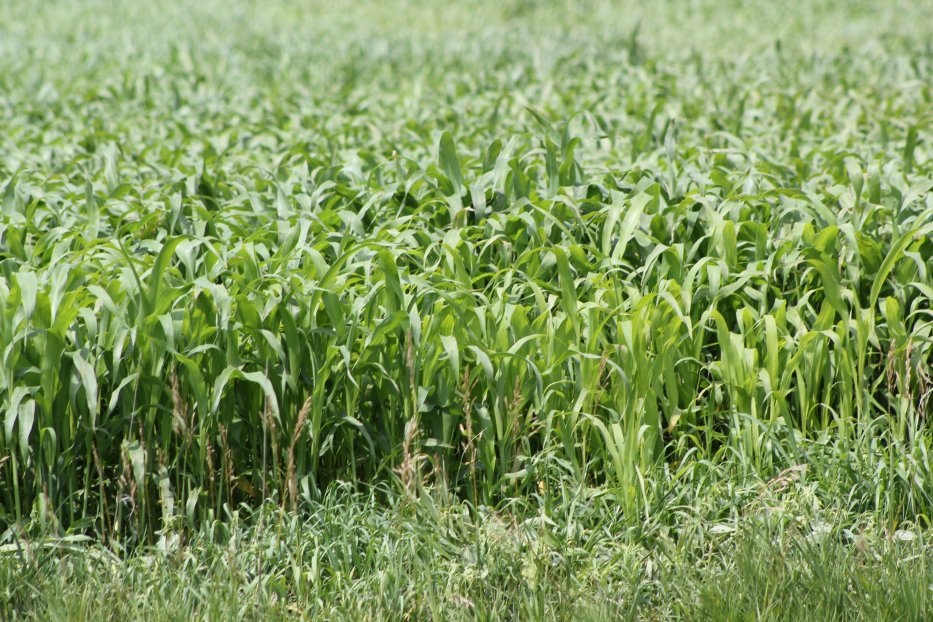
By Brad Schick, Nebraska Extension Educator
Grazing summer annual grasses is a great way to add flexibility to an operation, but in order to make it worth your time and money some management decisions are required. Your goals and your location will determine what type of summer annual you should plant. This article will address:
1. Type of annual and planting date
2. Timing of grazing
3. Prussic acid and nitrates
TYPE OF ANNUAL AND PLANTING DATE
The most common summer annuals for grazing are sorghum-sudangrass (often call sudex), sudangrass, pearl millet, foxtail millet, and teff. For forages that can be grazed slightly earlier, the sorghums and sudangrasses can be used, but should only be planted once the soil temperature is above 60 degrees Fahrenheit. Generally, a late May to early June planting date will meet the 60 degree Fahrenheit requirement.
For millets and teff, the soil temperature needs to be 65-70 degrees F before planting. Planting into soil that maintains a lower temperature can cause stunted growth and reduce forage yield. Planting mid- to late June and into July should give good results with enough water. The millets and teff are fairly drought tolerant, and more tolerant to drought than the sudangrasses and sorghums.
Another consideration for planting is forage availability. A good rule to follow is that forage will be ready to graze 6-8 weeks after planting. To reduce the chance of forage getting ahead of the cattle, stagger plantings of a forage type by two weeks. By staggering planting, rotational grazing can be implemented and the forage will be grazed more efficiently. Staggering of planting can be done using one forage type such as sorghum-sudangrass, or using two or more types. For example, sorghum-sudangrass is planted on a portion of the field. Two weeks later on the next portion of the field, sorghum-sudangrass or a different annual such as pearl millet is planted as long as temperature requirements are met.
TIMING OF GRAZING
Maximizing the harvest efficiency while grazing annual forages is a significant factor when planning the annual type and planting date. However, issues can occur when cattle moves are not managed properly. Use a short, rotational system for grazing. Fields should have a minimum of three paddocks to allow for regrowth after the first rotation. A goal should be to graze the paddocks for about 7-10 days and allowing regrowth for at least 14-20 days.
Grazing sorghum-sudangrass should be delayed until plants are 18-24 inches tall in order to avoid prussic acid poisoning, which can cause death in cattle. Sudangrass, foxtail and pearl millet, can be grazed once they reach 15-20 inches in height. Another guideline is to graze all these summer annuals leaving about 6-8 inches of stubble during that 7-10 day rotation. If choosing between leaving cattle on a paddock for a longer or shorter time, just remember that retaining some leaf area will cause more photosynthesis and ultimately a faster regrowth.
PRUSSIC ACID AND NITRATES
A significant concern for grazing some summer annuals is prussic acid poisoning, also known as cyanide poisoning. The regrowth and young leaves of the sorghums, sudangrasses, and sorghum-sudangrasses produce prussic acid and can be deadly if cattle consume a high concentration. Graze when the plants have reached an appropriate height and time the grazing periods appropriately. Turning cattle out full and with plenty of water will reduce the chance of prussic acid poisoning. Nitrates in grazing situations are generally not a concern if the forage isn’t grazed too low because the lower one-third of the plant will contain the highest nitrate concentration. Nitrates are something to watch when grazing any summer annual grass, even beyond drought years.
CONCLUSION
Grazing summer annual grasses can be a great addition to an operation when annuals are chosen correctly and grazing plans are used. Finally, planting a few extra acres of summer annuals is a good option as part of a drought plan for either grazing or haying. It’s also a fall back to the annuals grazing program just in case growth and regrowth isn’t as productive as planned. Summer annuals are also a great option before reseeding an aging alfalfa stand. This can provide quality hay or grazing. Setting clear goals can make grazing summer annuals worth your time and money.
For more information on this topic see NebGuide G2183 “Summer Annual Forage Grasses” (http://extensionpublications.unl.edu/assets/html/g2183/build/g2183.htm)
And “Planting Guidelines for Annual Forages” (https://beef.unl.edu/planting-annual-forages)
To listen to BeefWatch podcasts go to: https://itunes.apple.com/us/podcast/unl-beefwatch/id964198047 or paste http://feeds.feedburner.com/unlbeefwatch into your podcast app.